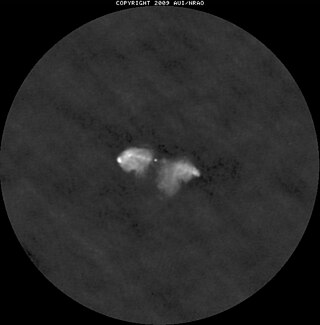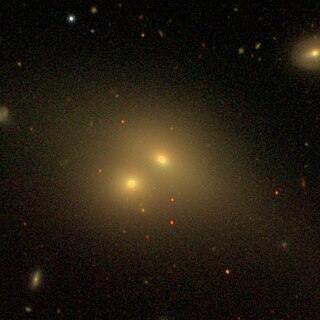
Messier 87 is a supergiant elliptical galaxy in the constellation Virgo that contains several trillion stars. One of the largest and most massive galaxies in the local universe, it has a large population of globular clusters—about 15,000 compared with the 150–200 orbiting the Milky Way—and a jet of energetic plasma that originates at the core and extends at least 1,500 parsecs, traveling at a relativistic speed. It is one of the brightest radio sources in the sky and a popular target for both amateur and professional astronomers.
A super star cluster (SSC) is a very massive young open cluster that is thought to be the precursor of a globular cluster. These clusters called "super" because they are relatively more luminous and contain more mass than other young star clusters. The SSC, however, does not have to physically be larger than other clusters of lower mass and luminosity. They typically contain a very large number of young, massive stars that ionize a surrounding HII region or a so-called "Ultra dense HII region (UDHII)" in the Milky Way Galaxy or in other galaxies. An SSC's HII region is in turn surrounded by a cocoon of dust. In many cases, the stars and the HII regions will be invisible to observations in certain wavelengths of light, such as the visible spectrum, due to high levels of extinction. As a result, the youngest SSCs are best observed and photographed in radio and infrared. SSCs, such as Westerlund 1 (Wd1), have been found in the Milky Way Galaxy. However, most have been observed in farther regions of the universe. In the galaxy M82 alone, 197 young SSCs have been observed and identified using the Hubble Space Telescope.

Ursa Major B or 3C 244.1 is a radio galaxy located in the constellation Ursa Major.

3C 285 is a radio galaxy located in the constellation Canes Venatici. It is located about 1 bilion light years away. It is a Fanaroff-Riley 2 radio galaxy and is hosted in a disturbed spiral galaxy.

3C 438 is a Seyfert galaxy and Fanaroff and Riley class II radio galaxy located in the constellation Cygnus. The radio galaxy has two lobes and there is a radio jet leading to the south lobe, which also has a prominent double hot spot. There is age variation across the lobes.

3C 236 is a Fanaroff and Riley Class II radio galaxy. It is among the largest known radio galaxies, with the radio structure having a total linear size in excess of 4.5 Mpc. The galaxy features a "double-double" radio morphology consisting of the giant relic 4.5 Mpc source and an inner 2 kpc compact steep spectrum radio source. A recent starburst episode near the nucleus may be related to the event resulting in re-ignition of radio activity.

NGC 3862 is an elliptical galaxy located 300 million light-years away in the constellation Leo. Discovered by astronomer William Herschel on April 27, 1785, NGC 3862 is an outlying member of the Leo Cluster.

NGC 6047 is an elliptical galaxy located about 430 million light-years away in the constellation Hercules. It was discovered by astronomer Lewis Swift on June 27, 1886. NGC 6047 is a member of the Hercules Cluster.

NGC 708 is an elliptical galaxy located 240 million light-years away in the constellation Andromeda and was discovered by astronomer William Herschel on September 21, 1786. It is classified as a cD galaxy and is the brightest member of Abell 262. NGC 708 is a weak FR I radio galaxy and is also classified as a type 2 Seyfert galaxy.

NGC 3367 is a barred spiral galaxy located in the constellation Leo. It is located at a distance of about 120 million light years from Earth, which, given its apparent dimensions, means that NGC 3367 is about 85,000 light years across. It was discovered by William Herschel on March 19, 1784.

NGC 541 is a lenticular galaxy located in the constellation Cetus. It is located at a distance of circa 230 million light years from Earth, which, given its apparent dimensions, means that NGC 541 is about 130,000 light years across. It was discovered by Heinrich d'Arrest on October 30, 1864. It is a member of the Abell 194 galaxy cluster and is included in the Atlas of Peculiar Galaxies in the category galaxies with nearby fragments. NGC 541 is a radio galaxy of Fanaroff–Riley class I, also known as 3C 40A.

NGC 545 is a lenticular galaxy located in the constellation Cetus. It is located at a distance of circa 250 million light years from Earth, which, given its apparent dimensions, means that NGC 545 is about 180,000 light years across. It was discovered by William Herschel on October 1, 1785. It is a member of the Abell 194 galaxy cluster and is included along with NGC 547 in the Atlas of Peculiar Galaxies.

NGC 547 is an elliptical galaxy and radio galaxy located in the constellation Cetus. It is located at a distance of circa 220 million light years from Earth, which, given its apparent dimensions, means that NGC 547 is about 120,000 light years across. It was discovered by William Herschel on October 1, 1785. It is a member of the Abell 194 galaxy cluster and is included along with NGC 547 in the Atlas of Peculiar Galaxies.

NGC 2273 is a barred spiral galaxy located in the constellation Lynx. It is located at a distance of circa 95 million light years from Earth, which, given its apparent dimensions, means that NGC 2273 is about 100,000 light years across. It was discovered by Nils Dunér on September 15, 1867.

3C 120, also known as Markarian 1506, is an active galaxy located in the constellation of Taurus, at a distance of about 420 million light years. It has been categorised as a type I Seyfert galaxy and a broad-line radio galaxy. 3C 120 has been found to be a variable source in all wavelengths and hosts a superluminal jet.

NGC 7720 is an elliptical galaxy located in the constellation Pegasus. It is located at a distance of about 380 million light years from Earth, which, given its apparent dimensions, means that NGC 7720 is about 180,000 light years across. NGC 7720 is the main galaxy of Abell 2634 galaxy cluster and is a radio galaxy. It was discovered by William Herschel on September 10, 1784.

NGC 5532 is an elliptical galaxy located in the constellation Boötes. It is located at a distance of about 250 million light years from Earth, which, given its apparent dimensions, means that NGC 5532 is about 110,000 light years across. It was discovered by William Herschel on March 15, 1784. It is a Fanaroff–Riley type 1 (FR1) radio galaxy.

NGC 7236 is an interacting lenticular galaxy located in the constellation Pegasus. It is located at a distance of about 300 million light years from Earth, which, given its apparent dimensions, means that NGC 7236 is about 150,000 light years across. NGC 7236 forms a pair with NGC 7237 and is a radio galaxy. It was discovered by Albert Marth on August 25, 1864.

NGC 7237 is an interacting lenticular galaxy located in the constellation Pegasus. It is located at a distance of about 350 million light years from Earth, which, given its apparent dimensions, means that NGC 7237 is about 240,000 light years across. NGC 7237 forms a pair with NGC 7236 and is a radio galaxy. It was discovered by Albert Marth on August 25, 1864.

NGC 3801 is a lenticular galaxy located in the constellation Leo. It is about 150 million light years from Earth, and estimated to be about 170,000 light years in diameter. William Herschel discovered it on 17 April 1784.





















